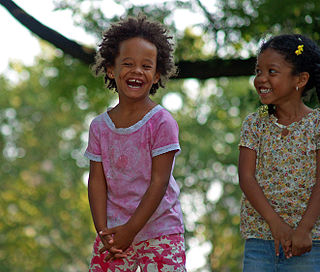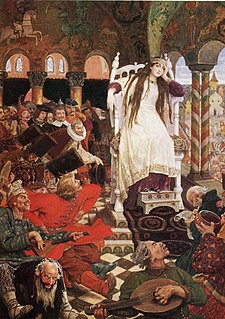 W
WLaughter is a physical reaction consisting usually of rhythmical, often audible contractions of the diaphragm and other parts of the respiratory system. It is a response to certain external or internal stimuli. Laughter can arise from such activities as being tickled, or from humorous stories or thoughts. Most commonly, it is considered an auditory expression of a number of positive emotional states, such as joy, mirth, happiness, relief, etc. On some occasions, however, it may be caused by contrary emotional states such as embarrassment, surprise, or confusion such as nervous laughter or courtesy laugh. Age, gender, education, language, and culture are all indicators as to whether a person will experience laughter in a given situation. Some other species of primate show laughter-like vocalizations in response to physical contact such as wrestling, play chasing or tickling.
 W
WLaughter in animals other than humans describes animal behavior which resembles human laughter.
 W
WSlash Coleman is an American storyteller, producer, and writer who lives in Richmond, Virginia. The author of "The Bohemian Love Diaries," a personal perspectives blogger for Psychology Today, and a laughter yoga teacher, he is best known for his one-man performance-based storytelling shows which combine clever wordplay, music, and poetic observations about family, spirituality, romantic relationships, and struggles to find a sense of home common with Generation X artists. His work is often compared to that of author David Sedaris.
 W
WThe "culture of popular laughter" is a cultural-historical term coined by the literary critic Mikhail Bakhtin in his book Rabelais and His World (1965). This studied popular culture in Renaissance Europe through the themes of François Rabelais' book Gargantua and Pantagruel (1532–64). The idea of the culture of popular laughter combines two literary ideas developed by Bakhtin in the same work: "grotesque realism" and "carnivalesque" which examined, respectively, the celebration of primary needs and the idea of carnival in which social norms were subverted.
 W
WDeath from laughter is a rare form of death, usually resulting from either cardiac arrest or asphyxiation, that has itself been caused by a fit of laughter. Instances of death by laughter have been recorded from the times of ancient Greece to modern times.
 W
WThe Ebert test gauges whether a computer-based synthesized voice can tell a joke with sufficient skill to cause people to laugh. It was proposed by film critic Roger Ebert at the 2011 TED conference as a challenge to software developers to have a computerized voice master the inflections, delivery, timing, and intonations of a speaking human. The test is similar to the Turing test proposed by Alan Turing in 1950 as a way to gauge a computer's ability to exhibit intelligent behavior by generating performance indistinguishable from a human being.If the computer can successfully tell a joke, and do the timing and delivery as well as Henny Youngman, then that's the voice I want.
 W
WFace with Tears of Joy (😂) is an emoji featuring a jovial face laughing, while also crying out tears. It can also be used for joking and teasing. It is the most commonly used emoji on social media websites such as Facebook, Snapchat, Twitter and Instagram. The emoji is also variously known as the lol emoji, joy emoji, laughing emoji, cry-laugh emoji or the laughing crying emoji.
 W
WGelotology is the study of laughter and its effects on the body, from a psychological and physiological perspective. Its proponents often advocate induction of laughter on therapeutic grounds in alternative medicine. The field of study was pioneered by William F. Fry of Stanford University.
 W
W"The Golden Goose" is a fairy tale collected by the Brothers Grimm. It is a tale of Aarne-Thompson type 571, with an episode of type 513B.
 W
WThe Princess Who Never Smiled, The Unsmiling Tsarevna or The Tsarevna who Would not Laugh is a Russian folk fairy tale collected by Alexander Afanasyev in Narodnye russkie skazki, as tale number 297.
 W
WA smile is formed primarily by flexing the muscles at the sides of the mouth. Some smiles include a contraction of the muscles at the corner of the eyes, an action known as a Duchenne smile. Among humans, a smile expresses delight, sociability, happiness, joy or amusement. It is distinct from a similar but usually involuntary expression of anxiety known as a grimace. Although cross-cultural studies have shown that smiling is a means of communication throughout the world, there are large differences among different cultures, religions and societies, with some using smiles to convey confusion or embarrassment.
 W
WLaughter is a physical reaction consisting usually of rhythmical, often audible contractions of the diaphragm and other parts of the respiratory system. It is a response to certain external or internal stimuli. Laughter can arise from such activities as being tickled, or from humorous stories or thoughts. Most commonly, it is considered an auditory expression of a number of positive emotional states, such as joy, mirth, happiness, relief, etc. On some occasions, however, it may be caused by contrary emotional states such as embarrassment, surprise, or confusion such as nervous laughter or courtesy laugh. Age, gender, education, language, and culture are all indicators as to whether a person will experience laughter in a given situation. Some other species of primate show laughter-like vocalizations in response to physical contact such as wrestling, play chasing or tickling.
 W
WLaughter yoga (Hasyayoga) is a modern exercise involving prolonged voluntary laughter. This type of yoga is based on the belief that voluntary laughter provides similar physiological and psychological benefits as spontaneous laughter. It is usually done in groups, with eye contact and much playfulness between participants. Intentional laughter often turns into real and contagious laughter.